Wild Horses Safari
Namibia Namibia: (IT-NAWHS)
URL: https://www.hiddentrails.com/tour/namibia_wild_horses_safari.aspx
Introduction
Namibia
Namibia
This adventurous ride takes us through some of the most breath-taking desertscapes on the planet. From the great dune sea of the central Namib to the very edge of the Sperrgebiet (German for restricted area), this ride covers diverse desert terrain - immense grassy plains, signature inselbergs, and the rugged Tiras Mountain Reserve. Namibia has given its communities the opportunity and rights to manage their wildlife through commercial conservancies, allowing you to reap the benefits of exploring true wilderness areas. You will be educated on the fragility of the desert and the conservation programs set in place.
Set for confident strong riders, this ride is a thrill for adventure seekers! Feel your heart pick up pace as you gallop along the never-ending expanse of the desert. The horses are sure-footed and amazingly hand-reared with love and dedication. The diversity of the herd, from the reliable horses who have done these trips countless times to the younger greener horses eager to please with a guiding hand, offers a horse for everyone!
Experience the serenity of sleeping under the stars while camping. The sight of the constellations is sure to take your breath away and leave you in awe on the beauty of the world we live in. This trip is amazing for appreciating the smaller things in life and experience the wonder the world has to offer.
Accomodation
Accommodations
This is a wilderness ride, so you will be staying in a mixture of lodges and camping.
Description
You will be staying in a lodge for 1 night and camp for 9 nights. Lodges are subject to changes based on availability.
Consider yourself ‘unplugged’ while on safari – cell-phone reception is minimal at best and internet not at all except in cities and larger towns.
Water is a very precious commodity in a desert, so while it is possible to rinse a few smalls things on safari, only lodges and hotels have laundry service.
Accommodation Itinerary - subject to changes based on availability
Night 1: Lodge in Windhoek
Night 2: Camping
Night 3-8: Camping in Namib desert
Night 9 & 10: Camping in Geistershlucht
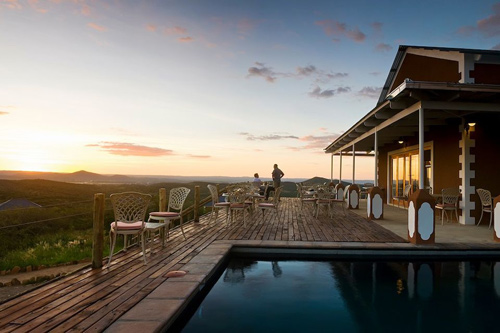
Lodge in Windhoek
The main lodge building comprises a dining room, a centrally situated bar, a lounge with fireplace, a conference room and a boardroom. Nestled outside, between the lounge and dining area, is the pool (great for swimming lengths – it really is quite long!) The elevated wooden deck offers a fairytale view of Windhoek. The Lodge and the rooms have been designed to emulate old German farm houses – think ‘stoep’ with ‘afdakkie’ and pots of geraniums. The 20 guest chalets consist of 14 twin chalets and 6 double chalets (all chalets have ensuite bathrooms with showers, toilets, and basins). Two of the chalets have been designed with honeymooners in mind and have baths instead of showers. All rooms have feather duvets wrapped in 100% cotton, environmentally friendly guest amenities, and unparalleled service and hospitality. 6 chalets offer views of Windhoek and 14 face east offering superb sunrise views of the Moltkeblick Mountain. You'll also have WIFI available.
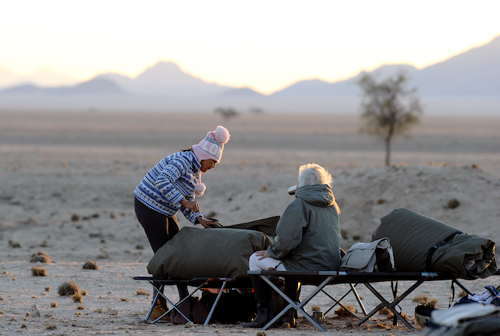
Camping
While we do provide tents if needed, generally guests sleep out under the stars on cozy cots with bedding. The cots have bedrolls consisting of an insulating mattress, duck-down double duvet, and pillow - can zip up and has a waterproof cover. Hot bucket showers and chemical loos travel along with us - we endeavor to provide a shower every night but if water is scarce, one night might be shower-less.
Room Occupancy
Single supplement is waived if you are willing to share.

Meals
All meals are included from dinner on Day 1 to breakfast on the last day.
Breakfast is typically porridge or cereal, coffee or tea and a hot dish.
On days we are able to meet up with the supply trucks a light lunch is served, where this is not possible, sandwiches are enjoyed under a shady tree.
Dinner is a delight of typically Namibian fare; wild Game, free-range beef or Karoo mutton served as braai (grilled over an open fire) or potjie (pot casserole) with vegetables and a surprise dessert also made on the open fire.
Tea, coffee, and juice are always available in camp with chilled drinks, beer, wine, etc. available in the evenings. All drinks are included in the cost whilst on the ride. Only drinks at the first night lodges, guest farms, restaurants, and petrol stations while en-route are not included in the package rate.
Dietary Restrictions
We can easily cater to vegetarians. We cannot fully cater to vegans, so please supply your own snacks.
This trip includes
some wine with dinner
and can accommodate special dietary requests.
Riding
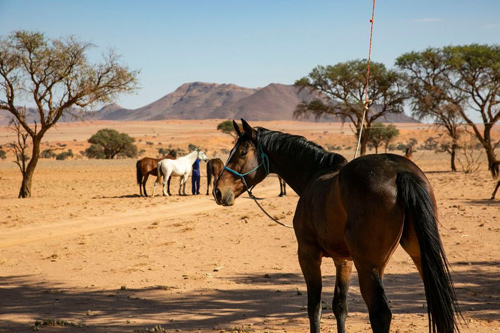
Riding Level
Do not underestimate the physical toll living outside take on you- come very fit! You need to be balanced in the saddle and stay off your horse's back without having to hang onto their mouth at all paces. You need to be able to post trot.
If you do not ride regularly (2 - 3 times a week), we strongly recommend that you get into practice before joining one of our challenging safaris. This is a challenging ride suitable for confident intermediate riders. Please not, we reserve the right to prevent anyone from riding if we feel they do not fulfill the minimum competence level as indicated or if weight and fitness level do not fall within that recommended for these challenging safaris.
Pace
You will ride in the morning for 4-5 hours, have a lunch break for 1-2 hours, and then continue riding for another 2-3 hours, totaling around 6-8 hours per day in the saddle for 7 days. You will cover 20-60km per day at all paces and over rough terrain. Other days may be less.
Pace depends on the terrain and temperatures as well as on fitness and weight of riders with walk, trot, canter and gallop. This ride includes the challenging crossing of the Namib dune sea as well as big, big plains for fast riding...and seeing the Namib's wild horses.
Because Namibia has such wide-open spaces, it is possible to accommodate up to 15 riders on most trails plus 2 - 3 riding guides.
Horses
Your horse will be chosen from a mixed herd of many breeds i.e. Arab, Haflinger, Trakehner, ranch horses, they are small to medium-sized (14.3 to almost 16 hands) sure-footed horses raised on rough terrain, some of them with experience in endurance riding, and every one of them a kind, reliable companion that deserves the very best treatment and care.
Each rider is responsible for grooming, regularly checking over, and tacking up their own horse (assistance is given when required). It is this experience that cements the bond between you and the horse you must rely on to carry you across the desert.
Tack
We use skirted endurance type saddles with heavy padding for the comfort of horse and rider. Each saddle is fitted with two specially made water bottle holders (water bottles supplied). If you normally ride with a sheepskin bumnah you may bring your own (western shaped). We use a simple snaffle bridle over the halter
Weight Limit
We have a strict weight limit of 85 kg dressed in your riding gear – fit riders heavier than this will need to hire a 2nd horse. Our absolute maximum weight limit is 93 kg.
Hard Hats
Hard hats are obligatory, unless medical insurers acknowledge that you will still be insured, should you choose not to wear a hard hat.
Safety
Your safety and enjoyment are of paramount importance to us while you are our guest. Please alert us to any personal medical condition, allergies included and ensure you have all essential personal medication before arriving in Windhoek.
Children & Non-Riders
Experienced children riders who are accompanied by their parents are welcome – but please remember that these rides can be quite strenuous – so parents must use their judgment as to whether their children are suitable. Anyone unable to keep up with the group may have to travel in the support vehicle at some times. Non-riding companions are also welcome to join the trip and travel with the trucks.
Insurance
Comprehensive medical insurance is required to ride with us. Ensure repatriation is included in your policy. Travel insurance is recommended.
Itinerary
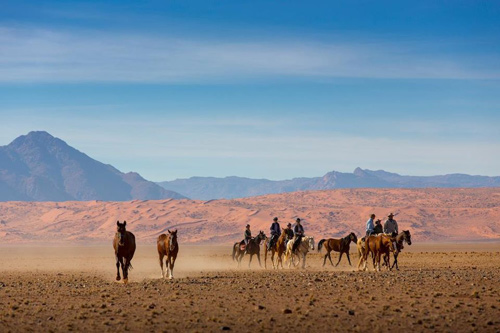
Sample Itinerary - subject to changes
Camp life has a leisurely pace - days begin at sunrise with the aroma of freshly brewed 100% Arabica coffee wafting through camp.
After a hearty breakfast we start riding around 8am for 4 - 5 hours. Lunch breaks are 1 - 2 hours, followed by another 2 - 3 hours riding in the afternoon.
Day 1: Arrival
Arrive Windhoek’s Hosea Kutako Airport before 17:00– airport transfer to overnight lodge where you will meet the other riders and guide for dinner and a briefing.
Day 2: Wolwedans
Early breakfast and then 5-hour transfer to our lunch spot in the quaint hamlet of Maltahöhe, followed by a decent down the picturesque Zaris Pass to our camp in the Tiras Biosphere Reserve. Settle in and explore your surroundings - here you will meet your crew, your horse and be instructed in how to be ‘desert savvy’.
Days 3 to 8: Tiras Mountains to Desert Wonderland
We set off up the rugged Tiras Mountains via one of the meandering dry washes coming down from the plateau above.
This unspoiled landscape has forced landowners to find sensitive ways to utilise this fragile area which is generally left to be natural. Boasting exceptional panoramic views from above - sentinel inselbergs (island mountains) dot the desertscape below with the distant dune sea towards which we are heading.
Desert adapted game are encountered during the day and open country with good going allows for some fast-paced riding. Lunch is enjoyed under a convenient tree or interesting spot with a good view. Overnight camps are chosen for their spectacular views - sleeping under the magnificent starry sky is a must - it has its own kind of magic. Few places on earth afford so little light pollution - allowing for an incomparable view of the magnificent southern constellation.
Our route may vary depending on weather conditions, or other circumstances but be assured every day will be memorable.
Crossing the dune sea is an experience in itself and you will come to appreciate why we chose this route - the remarkable desert-scapes on the far side are as true “Namib” as one can get.
Days 9-10: Wild Horses and Towns
From our last night camp in Geistershlucht (Ghost valley) we visit the waterhole of the Namib’s – the wild horses of the Namib - for a sundowner.
We then visit the coastal town of Luderitz, visiting the historic ‘ghost town’ of Kolmanskop – the colonial mining town the desert is ‘reclaiming’.
Day 11: Departure
After breakfast we transfer back to Windhoek Int Airport (just over 7-hour commute from Klein Aus) arriving in time for departure flights after 6:00 pm.
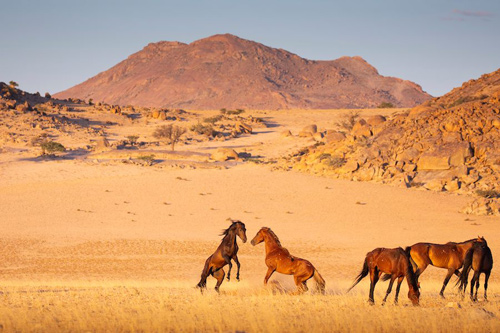
Rates and Dates for Wild Horses Safari
Rates include:
Accommodations, All meals, Transfers from/to Windhoek Airport, 7 riding days & Visit to the wild horses of the Namib, the town of Ludertiz, and Kolmanskop
* prices are per person based on double/twin occupancy
Transfer and Other Charges:
|
2023
|
Transfer from/to Windhoek Airport included
|
£
0
|
$0
|
|
2023
|
Single supplement - if requested only
|
£
240
|
$285
|
|
2023
|
Over 85 kg (extra horse charge)
|
£
1,000
|
$1,180
|
Dates Note:
Rates do not include:
Drinks and refreshments at lodges/restaurants, Insurance (mandatory) & Gratuities
Other Info
Meeting: Windhoek
Airport: Windhoek Int Airport
Transfer: Windhoek Int Airport
Climate:
Luderitz area
|
Month
|
Jan
|
Feb
|
Mar
|
Apr
|
May
|
Jun
|
Jul
|
Aug
|
Sep
|
Oct
|
Nov
|
Dec
|
|
Average High Temperature (°F)
|
76
|
75
|
75
|
74
|
72
|
71
|
69
|
68
|
68
|
70
|
71
|
74
|
|
Average Low Temperature (°F)
|
59
|
59
|
59
|
57
|
54
|
53
|
51
|
52
|
53
|
54
|
56
|
58
|
|
Average High Temperature (°C)
|
24
|
24
|
24
|
24
|
22
|
22
|
20
|
20
|
20
|
21
|
22
|
23
|
|
Average Low Temperature (°C)
|
15
|
15
|
15
|
14
|
12
|
12
|
11
|
11
|
12
|
12
|
13
|
15
|
|
Average Precipitation (days of rain)
|
0
|
0
|
0
|
0
|
0
|
0
|
0
|
0
|
0
|
0
|
0
|
0
|
Source: NOAA
Seasons
Lying between 29 and 17 degrees south of the equator and dominated by a subtropical high pressure zone, the Namib enjoys dry sunny weather much of the year. Parts of the Namib are classified as hyper-arid meaning potential evaporation is 350 times higher than precipitation. Rainfall (10 – 20 mm annually) in the desert is intermittent but life-giving precipitation from coastal fog, reaching up to 50 km inland and occurring for over 100 day’s a year sustaining fascinating desert adapted life.
Much of the country has very low average rainfall (when it does rain it is between October and April) and temperatures vary hugely seasonally and geographically – coastal areas much cooler than inland, often subject to fog (10 – 20 degrees Celsius). Day and night temperatures, particularly in winter, vary dramatically. Weather in desert is always highly variable and unpredictable – come prepared to all weather – layering is key to living in a desert.
An excellent weather report reference can be found on:
www.yr.no/place/Namibia
What To Bring:
What to Bring
Place all items in soft luggage, well labeled, and split into 2 bags if over 15kg- lots of pockets help with organizing.
Essential Items
Headlamp
Beanie / Woollen hat
Hat / Baseball cap
Fleece jacket
Buff / Bandana
Clothing
Long sleeved cotton shirts for riding x 4 (preferably in subtle colours)
Riding trousers/jods x 3
Casual trousers x 2 (for travelling and excursion days)
Shorts x 1 (in summer for around camp)
T-shirt x 2
Long sleeved shirts for the evenings x 2 (also for lodge nights)
Pullover x 2
Warm ‘Pyjamas’ x 1
Lightweight waterproof jacket (for foggy mornings)
Lightweight down jacket / vest
Underwear, Socks
Flip Flops
Comfortable walking shoes / trainers (for around camp, travel etc.)
Riding Gear
Helmet (recommended not compulsory, but might be a condition from your insurance – please check!) Sun visor to fit around helmet or Wide brimmed Hat (with a string)Boots / Chaps - full or half
Gloves
Seat saver (if needed)
Accessories
Sunglasses
Sunblock SPF 50 & Lip balm (with SPF!)
Toiletries (Shampoo, Toothbrush and -paste, wet wipes, moisturiser)
Personal medication / Pain killers (for sore muscles)
Camera
Power bank / extra batteries/ spare memory card
|
|